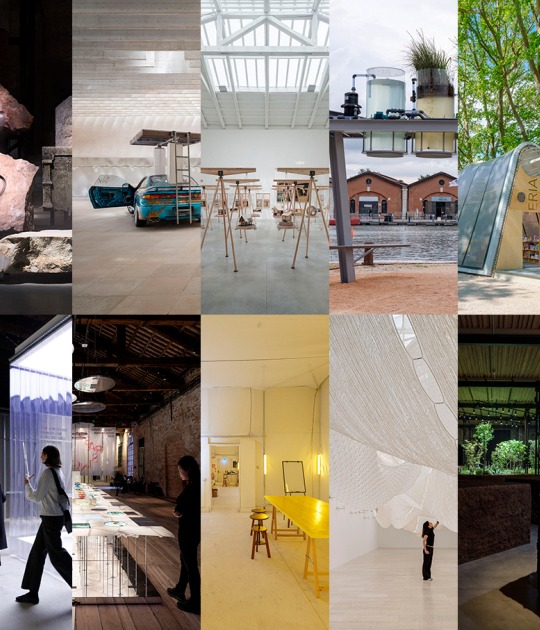The experience invites the viewer to immerse themselves in an interactive exhibition, in which they can visualize how people are constantly producing and disseminating heat and data around the world. Sixteen screens display real-time thermographic imaging technologies and 24 fans generate cool air as a contrasting reminder of the heat produced by data centers, all fixed to a frame of charred materials.
Description of project by ANNEX
Our lives are becoming increasingly entangled with data technologies. The Irish Pavilion brings the physicality of data infrastructure to the forefront with Entanglement, an exhibit addressing the environmental, cultural and human impact of data. The Pavilion aims to reframe the way we understand data production while exploring its impact on everyday life.
Entanglement will explore the materiality of data and the interwoven human, environmental and cultural impacts of communication technologies. The exhibition highlights how data production and consumption territorialise the physical landscape and examines Ireland’s place in the pan-national evolution of data infrastructure.
Ireland at Venice is an initiative of Culture Ireland in partnership with the Arts Council of Ireland. Curated by ANNEX (Sven Anderson / Alan Butler / David Capener / Donal Lally / Clare Lyster / Fiona McDermott), a collective of architects, artists and urbanists, Entanglement responds to the theme selected by the curator of the Biennale Architettura 2021 Hashim Sarkis: How will we live together? The exhibition aims to raise awareness about the materiality of the global internet and the cloud, which have infiltrated the Irish landscape through a vast constellation of data centres, fibre optic cable networks and energy grids.
Ireland has played a significant historical role in the evolution of global communications and data infrastructure. In 1866 the world’s first commercially successful transatlantic telegraph cable landed on Valentia Island on Ireland’s west coast. In 1901 the inventor of the radio, Guglielmo Marconi, transmitted some of the world’s first wireless radio messages from Ireland across the Atlantic to Newfoundland. Today Dublin has overtaken London as the data centre hub of Europe, hosting 25% of all available European server space. By the year 2027 Ireland’s data centres are forecast to consume a third of the country’s total electricity demand.
Entanglement uses the prism of heat to explore the material relationship between data infrastructure and architecture. The Pavilion asserts that the production and distribution of information is intrinsically connected to the production and distribution of heat.
EXHIBITION DESIGN
Entanglement draws from contemporary and historical data storage artefacts to establish the building blocks of the Pavilion’s structure. These artefacts are assembled in a campfire formation, referencing the forum where early human civilisations formed alliances, built social networks and eventually developed complex societies.
Entanglement invites its audience to experience a multisensory exhibition. Sixteen screens display real-time thermographic imaging technologies and 24 fans generate cool air as a contrasting reminder of the heat produced by data centres – all fixed to a frame of charred materials. In the background 30-minute soundscapes of Valentia Island, one of Ireland’s most westerly points, play in a loop through a series of speakers. Visitors are invited to sit on one of 15 bespoke seats made from server frames and slate sourced
from Valentia Island.
The Pavilion’s complex series of energy-intensive thermal transformations presents an immersive and performative visitor experience – from visualising how people are producing, consuming and disseminating data across the globe to bringing transparency to the local and planetary scale of data infrastructure networks, for example how a Facebook ‘like’ in Malaysia can trigger the emission of heat from a server on the outskirts of Dublin.
EXHIBITION CONTRIBUTIONS
ANNEX is an international multidisciplinary research and design collective. The work of its core team of architects, artists and urbanists operates between and beyond the subject areas of computer science, gaming platforms, technology and public space, data centres, sensor technology and large technical systems. Members include Sven Anderson, Alan Butler, David Capener, Donal Lally, Clare Lyster and Fiona McDermott.
Ireland at Venice is an initiative of Culture Ireland in partnership with the Arts Council of Ireland and in 2021 the Pavilion also has the support of: The Department of Tourism, Culture, Arts, Gaeltacht, Sport and Media; Royal Institute of Architects Ireland; TU Dublin School of Creative Arts; TU Dublin Graduate School of Creative Arts and Media; Trinity College Dublin; CONNECT Research Centre for Future Networks and Communications; University of Illinois at Chicago, Creative Activity Award; Valentia Slate; ARUP; Office of Public Works and Green on Red Gallery.












































